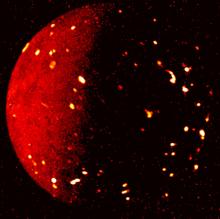Listen to today's episode of StarDate on the web the same day it airs in high-quality streaming audio without any extra ads or announcements. Choose a $8 one-month pass, or listen every day for a year for just $30.
You are here
Jupiter at Opposition II
You just can’t block a good storm. On Jupiter, for example, a storm as big as Texas muscled its way into a ring of even bigger storms. Scientists will keep an eye on it to see if it sticks around, and perhaps grows to the same size as the others.
The Juno spacecraft discovered the new storm last year. The craft has been orbiting Jupiter for four years. And last November, it passed just a few thousand miles above the south pole.
During earlier passes, the craft had found a set of six cyclones there, each about as wide as the continental United States. One of them was in the middle, almost directly atop the pole. The other five moved around it, forming a pentagon. And the system seemed to be pretty stable — the configuration stayed the same from pass to pass. By November, though, the new cyclone had joined the outer band, turning the pentagon into a hexagon.
The new storm was less than half the size of the older ones. But wind speeds at its perimeter were the same — about 225 miles per hour.
Jupiter’s south pole isn’t visible from Earth. But Juno will make other passes. The new views will tell us whether the new storm stays the same, grows, or perhaps vanishes — blocked by its bigger cousins.
And Jupiter itself is putting on a great show. It’s brightest for the entire year, shining like a brilliant star. It’s low in the southeast at nightfall, scoots low across the south during the night, and is in the southwest at dawn.





